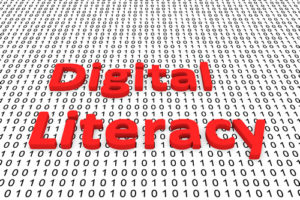A new survey casts doubt on whether college-educated adults have and are using digital literacy skills to critically examine information and news sources.
While 88 percent of respondents say they are confident in their critical thinking skills, only a minority received an “A” on a digital literacy test, according to a new national study from edtech firm MindEdge Learning.
Related content: Higher ed’s digital literacy resolutions
The third annual State of Critical Thinking study, commissioned by MindEdge and conducted by Qualtrics, finds that a large majority of college-educated Americans could not pass a basic, nine-question digital literacy, fake news identification, and critical thinking skills test. Fully 69 percent of survey respondents failed to answer more than five of the questions correctly.
Just 9 percent of respondents received an “A” by answering eight or nine questions correctly. These results varied noticeably by age: 13 percent of baby boomers (aged 55 to 73) received an “A,” while only 5 percent of millennials (aged 23 to 38) did likewise. Survey questions included topics related to website credibility, signs of fake or suspicious online content, and recognizing native advertising, among others.
Seventy-four percent of millennials, along with respondents with less than a four-year degree (76 percent), earned an “F” by answering five or fewer questions correctly. The failure rate was somewhat lower–but still quite high–among baby boomers (58 percent) and four-year college grads (62 percent).
“These survey results clearly show that low levels of digital literacy and the inability to discern fake or inaccurate information is a significant problem, especially among students and recent graduates who are primed to enter the workforce,” says Frank Connolly, director of communications and research at MindEdge. “As our workplaces embrace digital transformation, it’s increasingly important to bridge this skills gap to mitigate its effect on career growth and the accuracy of our collective knowledge.”
Digital literacy and the mainstream media
Eighty-four percent of respondents say critical thinking is important when assessing online content, and an equal proportion say that it is important to verify facts from a secondary source (85 percent).
Related content: 5 stellar examples of digital literacy in higher ed
There is no consensus as to whether the “mainstream media” and other offline news sources are more or less reliable than online content. About one-third (34 percent) say online sources are more reliable, compared to 28 percent who say offline sources are more reliable. Another one-third (34 percent) say that the two are roughly equal, in terms of reliability.
While a majority (57 percent) of respondents say the mainstream media do a “good” or “excellent” job of reporting the news fairly, there is no agreement that the media are doing a better job than they did 10 years ago. While 37 percent say the mainstream media are doing a better job than a decade ago, essentially the same number (38 percent) think they are doing a worse job.
At the same time, media consumption patterns suggest that a majority of Americans consume their news from non-mainstream sources. Fifty-four percent of respondents rank online publications among their top news sources, and another 48 percent rank social media among their top three sources. By contrast, only 43 percent rank “physical newspapers” among their top three sources–and only 32 percent say they read a “verified news source,” such as a print or online newspaper, on a daily basis.
Viral stories receive mixed trust levels
Survey respondents are split on whether a news story is more or less believable if it has gone viral. Forty percent of respondents say they are more likely to believe a viral story, while 35 percent say they are less likely to believe such a story.
A majority of respondents aged 18 to 22 (63 percent) and millennials (51 percent) think a story is more accurate if it has gone viral. By contrast, more baby boomers (50.4 percent) think that a viral story is probably less accurate.
Hard skills and soft skills
Despite the low scores on the digital literacy/critical thinking test, study participants expressed a high level of confidence (88 percent) in their soft skills, including critical thinking. They are less confident in their hard skills (72 percent).
In assessing the relative importance of hard and soft skills, respondents were slightly more likely to say that soft skills are more important: 27 percent say a worker’s skill set should be “majority soft skills,” compared to 20 percent who say it should be “majority hard skills.” However, close to half (47 percent) say that a worker’s skill set should include a roughly equal distribution of hard and soft skills.
Almost four-of-five (79 percent) survey respondents say that workers can learn to improve their soft skills through education and training.
- First-generation students are more likely to seriously consider leaving college - April 17, 2024
- How higher ed can meet workforce needs - April 15, 2024
- Higher ed leaders believe continuing education units are undervalued - April 10, 2024

